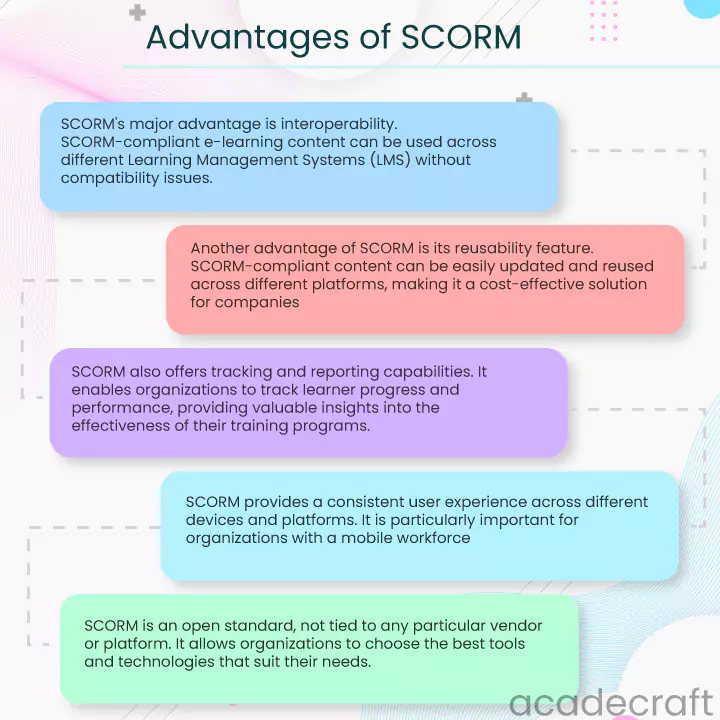
Creating eLearning content can be very challenging, especially if you're new to digital learning. However, if you want to easily create shareable content across various platforms, you must consider SCORM compliance. This beginner's guide will walk you through creating rich SCORM-compliant content. From the basics of SCORM to creating and finalizing your content for publishing and distribution, you will get an insight into everything you seek. Whether you are a teacher, trainer, or instructional designer, this guide will provide all the information you need to know how to create SCORM content.
SCORM (Sharable Content Object Reference Model) is a set of multiple technical standards that ensures eLearning content can be shared and reused in various Learning Management Systems (LMS). It establishes how eLearning content should be packaged in different systems.
In a study published by software advice, it has been found that 62% of businesses that use e-learning for employee training use SCORM-based courses.
SCORM-compliant content can be delivered in a consistent, standardized format across multiple platforms. It makes it easier for learners to access content anywhere, anytime, and on any device and portrays how digital content and systems communicate.
A SCORM Package is a zipped file containing webpages, multimedia, and metadata describing how the files should be used. It is widely used in the eLearning industry to deliver content to learners.
SCORM Package is designed to enable interoperability between LMS and eLearning content. It allows the content and the LMS to “talk” to each other.
SCORM enables the content to interact with the LMS and report back on how it has been used. It works by providing a common language for systems and content to communicate.
This language is based on a set of standards and protocols that allow for the sharing and reuse of content. In addition, it tracks learning progress. SCORM standards and protocols are based on XML and HTML.
For example, SCORM can provide a consistent navigation interface, allowing learners to move between different pieces of content stored in multiple locations. It also ensures that all the content is tracked the same way so learners receive consistent feedback on their progress. By employing effective corporate eLearning solutions, businesses can effectively enhance their growth in the eLearning industry.
Bonus Read: Learning Objectives of Corporate eLearning
The functionality of SCORM is not as complicated as many people believe. The entire work of SCORM is interpreted by its two main components: Sharable Content Object (SCO) and Reference Model (RM).
Several versions of SCORM have been released over the years, each with unique features and capabilities. The most popular versions of SCORM include SCORM 1.2, SCORM 2004, and SCORM 2.0.
Additional: xAPI (Experience API) enables tracking learning experiences beyond traditional e-learning environments, such as mobile devices or simulations.
SCORM is widely used in the eLearning industry and offers numerous advantages.

Bonus Read: What is SCORM Compliant LMS
Choosing an authoring tool is essential for the creation of SCORM-compliant learning content. The authoring tool chosen should support the output of SCORM-compliant content. It should also provide features such as the ability to develop numerous forms of media, track user progress, and measure learning outcomes.
The authoring tool should allow users to easily organize the content into a logical structure with clearly defined objectives and assessments. It should also enable the user to create, edit, and preview the course structure quickly.
The tool should make adding media such as images, video, and audio easy to help engage learners and promote the learning experience. The user should quickly add and edit the content and multimedia, allowing them to customize the course to their specific needs. The tool should allow the user to preview the course structure, allowing them to ensure it meets their expectations.
By using these interactive elements, instructors can better understand the student's comprehension and progress. This feedback can tailor the instruction to the student's specific needs, leading to better learning effects and a more practical learning experience. You can do this by taking advantage of effective gamified learning solutions.
Once the content has been written, edited, and approved, it will be published. Make sure to give your content the attention it deserves regarding formatting, layout, and design, as these elements play an integral role in the reader’s experience.
|
Pros |
Cons |
|
An interactive experience for the learner |
Extra expenditure due to the cost of the authoring tool |
|
Good control of time spent over the course |
For new users, there may be a steep learning curve |
|
More options for combining course components and assessments |
It can be hard to use as its an old standard |
|
Content migration to an LMS is made easier. |
In this blog, we have discussed how to create SCORM content: its working, components, advantages and steps that enable software to communicate with Learning Management Systems. It is imperative to create content that can be accessed and tracked by an LMS.
SCORM-compliant content allows learners to monitor their progress and have their scores stored and tracked within an LMS. It also helps to ensure that content can be accessed and used across multiple platforms.
Our custom eLearning content development services can assist you in making your content and educational resources SCORM-compliant. We have SCORM-compliant solutions that can assist you in making your dreams come to reality.
Share